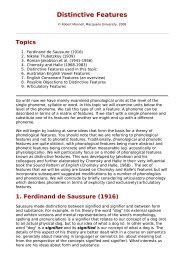The Syllable and the Foot : Summary - Speech Resource Pages
The Syllable and the Foot : Summary - Speech Resource Pages
The Syllable and the Foot : Summary - Speech Resource Pages
You also want an ePaper? Increase the reach of your titles
YUMPU automatically turns print PDFs into web optimized ePapers that Google loves.
(3) Associate any weak syllables with <strong>the</strong> foot that precedes <strong>the</strong>m.<br />
As a result of this, we get two binary feet:<br />
(4) If <strong>the</strong>re is more than one syllable, one of <strong>the</strong> feet has to marked<br />
strong, <strong>and</strong> <strong>the</strong> o<strong>the</strong>r(s) as weak. <strong>The</strong> foot that is marked strong is<br />
<strong>the</strong> one that dominates <strong>the</strong> primary stressed syllable (<strong>the</strong> third<br />
syllable in this example). So <strong>the</strong> first foot is weak. We <strong>the</strong>refore<br />
arrive at:<br />
(5) Join up <strong>the</strong> feet to form word tree. If <strong>the</strong>re is an initial weak<br />
syllable (doesn't apply in this case, but it would in e.g. 'asparagus')<br />
join that to <strong>the</strong> word level. We <strong>the</strong>refore have <strong>the</strong> following with <strong>the</strong><br />
transcription included:
















